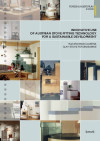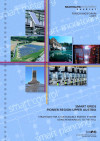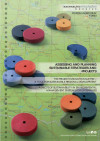Suchergebnisse für "Factsheet: Energietechnologien gestalten, die für alle sinnvoll und nutzbar sind"
Solar Heating And Cooling in Austria (Faninger, 2009)

Status Report 2009 on Research, Development and Market Deployment of Solar Thermal Technologies in Austria. Presented to the IEA Solar Heating and Cooling Programme in July 2009
Innovative Use Of Austrian Stove Fitting Technology For A Sustainabl Development

Tile stoves in Austria - Clay stoves in Zimbabwe
Forschungsforum
2/2000
Herausgeber: BMVIT
Englisch, 6 Seiten
Downloads zur Publikation
Research and Innovation for Heating and Cooling with Renewable Energy Sources

position paper related to biomass, geothermal energy, solar thermal energy and heat pumps in order to support persons responsible for Austrian energy research programs to define main research and innovation topics for renewable heating and cooling within these programs
Schriftenreihe
28/2014
Englisch
Smart Grids Pionier region Upper Austria

Strategies for a sustainable energy system using renewables to the full
Forschungsforum
1/2011
Herausgeber: BMVIT
Englisch, 6 Seiten
Downloads zur Publikation
Sanierung PRO!

The goal of the project is the development of a guideline, which supports builders and planners or consultants in the organization and monitoring of inhabitant integration into the reorganization processes of multi-storey housing.
Assessing And Planning Sustainable Strategies And Projects

The Project Innovation Matrix - A Tool For Sustainable Regional Development Aspects Of Sustainability In Environmental Management Systems For Enterprises
Forschungsforum
1/2003
Herausgeber: BMVIT
Englisch, 6 Seiten
Downloads zur Publikation
Einfach:wohnen, Phase Construction

Support for the erection of the demonstrative housing project consisting of 7 houses (5 Low energy houses, 1 passive house and 1 "next to passive house")
SolarUpdate Vol. 51 (November 2009)

Newsletter of the IEA Solar Heating and Cooling Programme, Topics: Renovating houses to meet high energy standards, Solar Forecasting to Support District Heating in Austria, country spotlight - solar thermal in france, Solar + Heat Pumps, Harmonization of Testing Standards and Certification Requirements
Englisch
First rehabilitation project of a public building to reach passive-house standard

General rehabilitation of the General Secondary School II and the Poytechnic School at Schwanenstadt (Upper Austria) using prefabricated timber wall elements and a newly developed ventilation system optimised for schools
GAINING BUILDING LAND without expansion - development of single-family housing settlements

Identifying and utilising potentials for higher densities and re-structuring in single-family housing areas requiring renewal
OPTISOL - Demonstration objects accompanied by measurement techniques for optimised and standardised solar systems in the construction of residential buildings for several families

The implementation of optimised solar heat supply systems in the construction of residential buildings for several families within the framework of an in-depth test.
S-House: Planning and Building for the future

The S-House is a two-storey straw-bale passive solar design. The building shell demonstrates the potential of straw-bale building and shows the whole spectrum of technical solutions for competitive components made of renewable resources.
Energy-storage concrete: Thermal Component Activation

This planning guide provides information on the option of solely heating and cooling small-volume residential buildings by means of thermal component activation (TCA). Concrete instructions on the planning of residential buildings with thermally-activated ceilings are also provided.
Felix Friembichler, Simon Handler, Klaus Krec, Harald Kuster
Herausgeber: BMVIT
Englisch, 122 Seiten
Downloads zur Publikation
IEA SHC Solar Newsletter "Sustainable SolarHousing" Vol .44 October 2005

Experts in the joint work of the IEA Solar Heating and Cooling Programme and the IEA Energy Conservation in Buildings and Community Systems, SHC Task 28/ECBCS Annex 38: Sustainable Solar Housing, collaborated to research how better to build very low energy, solar housing.
Englisch
Industrial Process Indicators and Heat Integration in Industries (Brunner/Slawitsch/Giannakopoulou/Schnitzer 2008)

The goal of this report, developed in the framework of the Task33/IV - Solar Heat for Industrial Processes (SHIP) of theInternational Energy Agency, is to give an overview of the toolswhich have been developed within this IEA Task 33/IV.
Englisch
Rebuilding of the organic farm Achleitner, straw & clay - room climatisation with plants

Rebuilding of a marketing-, store- and processingcenter with an organic freshmart and an organic restaurant in passivhouse quality. Application of regional building materials, an innovatve overall energyconcept, climatisation with plants.
Process Heat Collectors State of the Art within Task 33/IV (Weiss/Rommel 2008)

Approximately 128 GWth, the equivalent of 183 million square meters, of solar thermal collectorswere installed by the year 2006 worldwide (Weiss et al., 2008). Until now, the widespread use of solarthermal applications has focused almost exclusively on swimming pools and residential domestichot water preparation and space heating.
Englisch
Solar Heat Worldwide - Markets and Contribution to the Energy Supply 2005

The solar thermal collector capacity in operation worldwide equaled 107.8 GWth corresponding to 154 million square meters at the end of the year 2005. Of this, 90.7 GWth were accounted for by flat-plate and evacuated tube collectors and 16.2 GWth for unglazed plastic collectors. Air collector capacity was installed to an extent of 0.9 GWth.
Englisch
User-friendly heating and ventilation systems for low energy and passivehouses

The goal of the research project is the evaluation of different heating and ventilation systems for passive- and low energy multi family and office buildings taking into account indoor climate, possible variation of user behaviour, final and primary energy demand, costs, space demand and fail save installation and operation.
Design Guidelines - Solar Space Heating of Factory Buildings With Underfloor Heating Systems (Jaehnig/Weiss 2008)

The energy required for the space heating of factory buildings and warehouses can be a major percentageof the energy consumption of a company. While in some cases, waste heat from other processesin the company is available and is the most cost effective way to heat a factory building, aninteresting option is to use solar energy to cover the heat demand of an industrial building.
Englisch
